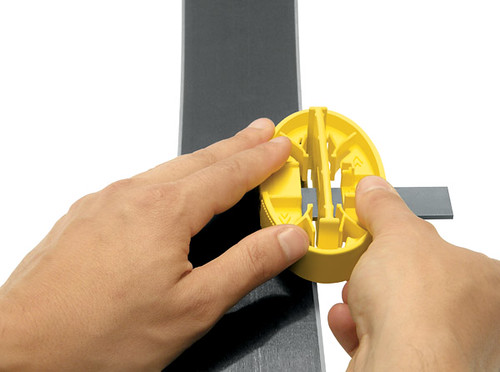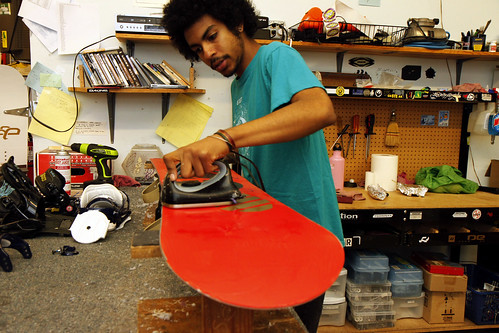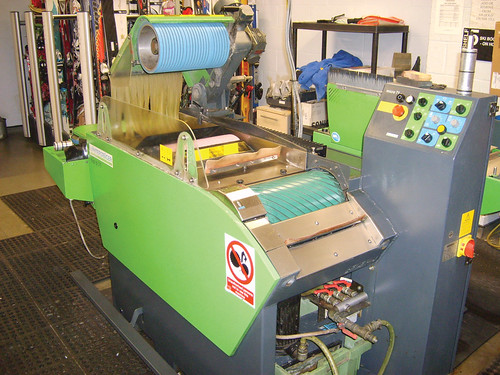Ski servicing is the regular maintenance of your skis or snowboard. The benefit is two-fold: it’ll enhance your on-snow experience and help look after your investment for years to come.
OnTheSnow called upon Phil Gordon, Ski Equipment Buyer for Snow+Rock. Phil gave us his tips on what basic ski servicing you can do at home and when to take your skis or snowboard into the shop for some much-needed pampering.
Is ski servicing easy at home?
You can quickly and easily do a basic job of ski servicing at home. You just need to make a small investment in a few key tools and materials which will help improve your on-snow experience. Phil says the two best things you can do at home are to clean and sharpen the edges and wax the base.
So what tools and materials do you need for ski servicing at home? For people starting out, Phil recommends purchasing something like the TOKO Ergo Race tuning tool. As well as some universal wax, a waxing iron and a plastic scraper. Ideally, you should look at getting a set of vices too to make holding the ski safer and easier.
Tuning
The process of cleaning and sharpening the edges of your skis or snowboard is called ‘tuning’. By achieving sharp edges and removing any rust and chips, the glide and control will improve.
Phil says, “The benefit of the TOKO Ergo Race tuning tool is that it has a file included. It also has set angles for tuning the equipment so there is no need to guess what angle the file is at. A few quick passes of the tool will help keep the edges nice and sharp.”

TOKO Ergo Race tuning tool is designed for side-edge tuning.
Waxing
“Ski and board bases are like skin and need to have the moisture replaced,” says Phil. “A hot wax helps replace the moisture into the pores of the base. This makes the ski move faster, smoother and helps make turning easier.”
Phil recommends using a wax iron rather than a clothes iron. This is because the wax iron is more accurate in temperature and does not have steam holes on the base where wax can clog. “The big thing to remember is never let the wax smoke as doing this burns off the essential factors that make the wax slippery.”
Phil’s step-by-step to waxing skis, snowboards:
– To start, drip a small bead of wax along the length of the equipment
– There should be enough wax so that there is a thin layer between the iron base and ski.
– Be sure to keep the iron moving to avoid any hot spots on the base
– When the wax is cold and the pores have closed up, use a plastic scraper to remove excess wax to leave a smooth finish on the base. You can also finish off the base by using a nylon brush. Be sure to remove any wax that is left on the edges.

Ski servicing in the workshop
In the Snow+Rock workshop, you can have all sorts of repairs done, like sharpening and tuning edges, replacing base material and installing new edges. The most requested ski service is the full service, so what does it include?
The full service
Repairing . . . Any small scratches and holes are filled with industrial P-Tex. When cool, it is scraped off and the base material is levelled out.
“The key factor in the full service is having structure embedded in the base,” says Phil. “The structure works like a tyre tread. Where a tyre works to pump water away allowing for more grip. The structure helps regulate how much fluid is under the base helping the ski slide smoother and faster. The rule of thumb would be that a fine thin linear structure is good for cold dry snow and a coarse cross structure is better for more damp conditions.”
Tuning . . . The tuning takes place on one of the ceramic edging machines. These discs, which are concave cup-shaped, sharpen, tune and polish the edge as it passes along the length of the ski or board. One pass will do the base edges and one pass will to the side edge. The process also removes rust and sets the edges.
Waxing . . . Wax will be applied to the base to help make the most of the tune and put needed moisture back in.

When is ski servicing necessary?
To make sure equipment is kept in the best shape possible, Phil recommends getting a full service done at the start of the year. He also says wax your skis every day while on holiday and touch up the edges to remove any nicks or burrs. When you come home you can either maintain your equipment with your own tools or get an edge and wax done in store. If you’ve got stone or edge damage, he says you may want to consider a more in-depth service.
At the end of the year, it is important to place a storage wax on your equipment. This can be done in a workshop or at home. A thick layer of wax is applied to the base and over the edges, but Phil says the most important thing is that it is not scraped off. This helps prevent the base and edges from oxidizing in the summer months.
Should you really try it at home? Well, the Brave Ski Mom says, “If you ski a lot in one season, tuning your own skis may save you a lot of money. Sure you have the initial investment in tools and wax. But after that first layout, you’ll be saving money. You’ll also have more control over the condition of your skis.”




